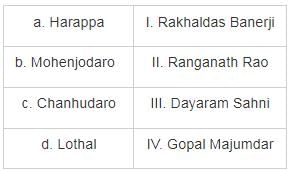UPPSC GS I Practice Test - 16 (Old Pattern) - UPPSC (UP) MCQ
30 Questions MCQ Test - UPPSC GS I Practice Test - 16 (Old Pattern)
Consider the following pairs:

Which of the pairs given above is/are not correctly matched?

Match the following explorers of Sindhu civilization with cities discovered by them:


What is the name of the initiative launched by HRD Minister Ramesh Pokhriyal for Higher Educational Institutions?
Eleventh Schedule of the Constitution of India belongs to which of the following Article?
The election to constitute a Panchayat should be completed before the expiration of a period of______ from the date of its dissolution.
Which of the following statements is/are correct regarding the Attorney General for India?
1. The remuneration of the AG is not fixed by the Constitution. He receives such remuneration as the President may determine.
2. The prior consent in writing of the Attorney General is not required for the Supreme Court to initiate criminal contempt action.
Consider the following statements about the Ramsar convention
1. It is an international treaty for the conservation and wise use of wetlands.
2. Montreux Record is kept as a part of the Ramsar List
3. Chilka Lake (Odisha) was placed in the Montreux record but was later removed from it
Which of the above statements is/are correct?
Which of the following do NOT form part of a strategy of sustainable development?
According to the 2011 Census Mirzapur district has a population of 2,496,970, roughly equal to the nation of Kuwait or the US state of Nevada. This gives how much ranking in India (out of a total of 640)?
PM SVANidhi is a micro credit scheme for _____.
In October 2020, Department of Posts has entered into an agreement with Postal Service of which country for the electronic exchange of customs data related to postal shipments exchanged between the two countries?
India and which of the following countries will reopen the Chilahati-Haldibari rail link nearly after 55 years?
Calcium carbide is used for artificial ripening of green fruits because it produces
Which of the following substances is used in black and white photography?
Which of the following is/are the uses of Algae?
1. Carbon dioxide fixation
2. Purification of wastewater
3. Food supplements
4. Biofuel production
Select the correct answer using the code given below.
If a plant has high ozone-forming potential, it means
Which wildlife sanctuaries is a tri-state protected area in northern India, Which is also famous for the Critically Endangered gharial and Dolphin?
Which of the following is tropical grassland?
Which of the following rivers originates in the Saharanpur district in Uttar Pradesh?
Which of the following regions of Uttar Pradesh was known as 'Chedi' during Sixth Century B.C.?
What is the name of the initiative launched by the Railway Police Force to ensure the security and safe travel to the women passengers?
In which among the following states will India’s first National maritime heritage museum be built with the aim to boost the underwater or marine archaeology?
After Sikkim, the first Union Territory to become 100 per cent organic is
Match List - I with List-II and select the correct answer using the codes given below the lists:

Who was the chief supervisor of the collection of revenue from the whole kingdom In Mauryan administration?
Consider the following statements regarding CAATSA.
1. CAATSA stands for Countering America’s Adversaries through Sanctions Act (CAATSA).
2. These sanctions comprise a ban on granting specific US export licences and authorizations for any goods or technology.
Which of the statements given above is/are correct?
Match the following pairs:

Which of the following codes are correctly matched?
Which among the following statements are NOT correct with respect to Round Table Conferences during British Rule?























